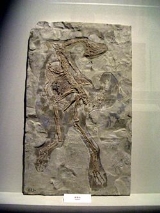
Caudipteryx
Overview
Caudipteryx is a genus
of peacock-sized theropod dinosaur
s that lived in the Aptian
age of the early Cretaceous
Period (about 124.6 million years ago). They were feather
ed and remarkably bird
like in their overall appearance.
Two species
have been described; C. zoui (the type species), in 1998, and C. dongi, in 2000.
Caudipteryx fossil
s were first discovered in the Yixian Formation
of the Sihetun area of Liaoning
Province, northeastern China
in 1997.
Caudipteryx, like many other maniraptora
ns, has an interesting mix of reptile- and bird-like anatomical features.
Caudipteryx had a short, boxy skull
with a beak-like snout that retained only a few tapered teeth in the front of the upper jaw.
Genus
In biology, a genus is a low-level taxonomic rank used in the biological classification of living and fossil organisms, which is an example of definition by genus and differentia...
of peacock-sized theropod dinosaur
Dinosaur
Dinosaurs are a diverse group of animals of the clade and superorder Dinosauria. They were the dominant terrestrial vertebrates for over 160 million years, from the late Triassic period until the end of the Cretaceous , when the Cretaceous–Paleogene extinction event led to the extinction of...
s that lived in the Aptian
Aptian
The Aptian is an age in the geologic timescale or a stage in the stratigraphic column. It is a subdivision of the Early or Lower Cretaceous epoch or series and encompasses the time from 125.0 ± 1.0 Ma to 112.0 ± 1.0 Ma , approximately...
age of the early Cretaceous
Cretaceous
The Cretaceous , derived from the Latin "creta" , usually abbreviated K for its German translation Kreide , is a geologic period and system from circa to million years ago. In the geologic timescale, the Cretaceous follows the Jurassic period and is followed by the Paleogene period of the...
Period (about 124.6 million years ago). They were feather
Feather
Feathers are one of the epidermal growths that form the distinctive outer covering, or plumage, on birds and some non-avian theropod dinosaurs. They are considered the most complex integumentary structures found in vertebrates, and indeed a premier example of a complex evolutionary novelty. They...
ed and remarkably bird
Bird
Birds are feathered, winged, bipedal, endothermic , egg-laying, vertebrate animals. Around 10,000 living species and 188 families makes them the most speciose class of tetrapod vertebrates. They inhabit ecosystems across the globe, from the Arctic to the Antarctic. Extant birds range in size from...
like in their overall appearance.
Two species
Species
In biology, a species is one of the basic units of biological classification and a taxonomic rank. A species is often defined as a group of organisms capable of interbreeding and producing fertile offspring. While in many cases this definition is adequate, more precise or differing measures are...
have been described; C. zoui (the type species), in 1998, and C. dongi, in 2000.
Caudipteryx fossil
Fossil
Fossils are the preserved remains or traces of animals , plants, and other organisms from the remote past...
s were first discovered in the Yixian Formation
Yixian Formation
The Yixian Formation is a geological formation in Jinzhou, Liaoning, People's Republic of China, that spans 11 million years during the early Cretaceous period...
of the Sihetun area of Liaoning
Liaoning
' is a province of the People's Republic of China, located in the northeast of the country. Its one-character abbreviation is "辽" , a name taken from the Liao River that flows through the province. "Níng" means "peace"...
Province, northeastern China
China
Chinese civilization may refer to:* China for more general discussion of the country.* Chinese culture* Greater China, the transnational community of ethnic Chinese.* History of China* Sinosphere, the area historically affected by Chinese culture...
in 1997.
Caudipteryx, like many other maniraptora
Maniraptora
Maniraptora is a clade of coelurosaurian dinosaurs which includes the birds and the dinosaurs that were more closely related to them than to Ornithomimus velox. It contains the major subgroups Avialae, Deinonychosauria, Oviraptorosauria and Therizinosauria. Ornitholestes and the Alvarezsauroidea...
ns, has an interesting mix of reptile- and bird-like anatomical features.
Caudipteryx had a short, boxy skull
Skull
The skull is a bony structure in the head of many animals that supports the structures of the face and forms a cavity for the brain.The skull is composed of two parts: the cranium and the mandible. A skull without a mandible is only a cranium. Animals that have skulls are called craniates...
with a beak-like snout that retained only a few tapered teeth in the front of the upper jaw.
Unanswered Questions
Discussions

